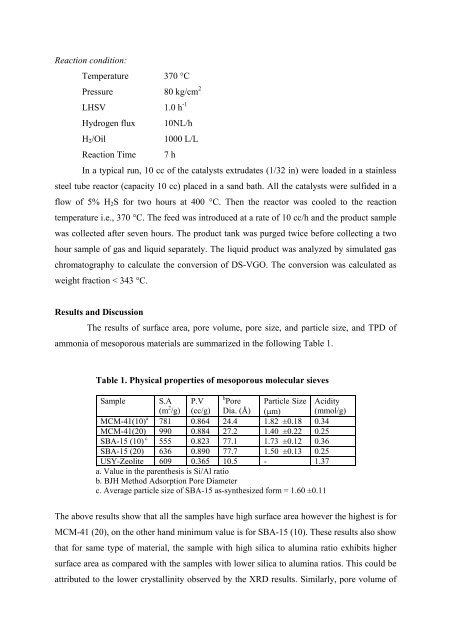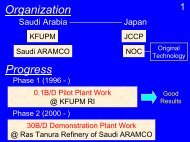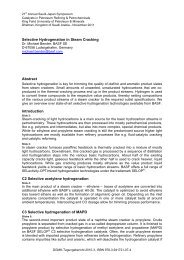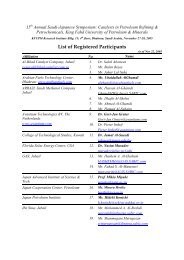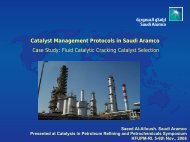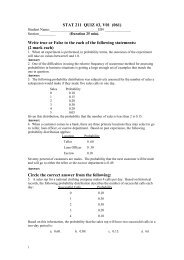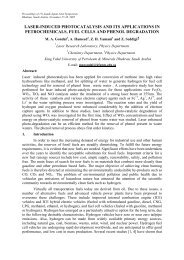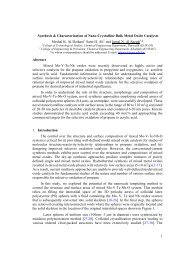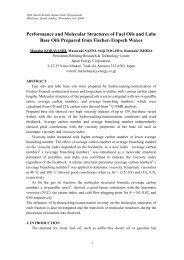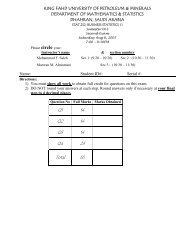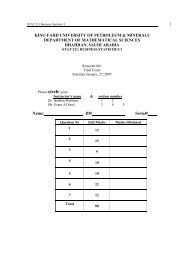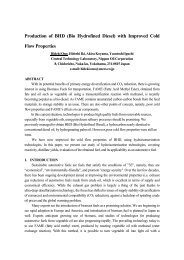preparation of mesoporous molecular sieve based hydrocracking
preparation of mesoporous molecular sieve based hydrocracking
preparation of mesoporous molecular sieve based hydrocracking
You also want an ePaper? Increase the reach of your titles
YUMPU automatically turns print PDFs into web optimized ePapers that Google loves.
Reaction condition:<br />
Temperature 370 °C<br />
Pressure 80 kg/cm 2<br />
LHSV 1.0 h -1<br />
Hydrogen flux 10NL/h<br />
H 2 /Oil<br />
1000 L/L<br />
Reaction Time 7 h<br />
In a typical run, 10 cc <strong>of</strong> the catalysts extrudates (1/32 in) were loaded in a stainless<br />
steel tube reactor (capacity 10 cc) placed in a sand bath. All the catalysts were sulfided in a<br />
flow <strong>of</strong> 5% H 2 S for two hours at 400 °C. Then the reactor was cooled to the reaction<br />
temperature i.e., 370 °C. The feed was introduced at a rate <strong>of</strong> 10 cc/h and the product sample<br />
was collected after seven hours. The product tank was purged twice before collecting a two<br />
hour sample <strong>of</strong> gas and liquid separately. The liquid product was analyzed by simulated gas<br />
chromatography to calculate the conversion <strong>of</strong> DS-VGO. The conversion was calculated as<br />
weight fraction < 343 °C.<br />
Results and Discussion<br />
The results <strong>of</strong> surface area, pore volume, pore size, and particle size, and TPD <strong>of</strong><br />
ammonia <strong>of</strong> <strong>mesoporous</strong> materials are summarized in the following Table 1.<br />
Table 1. Physical properties <strong>of</strong> <strong>mesoporous</strong> <strong>molecular</strong> <strong>sieve</strong>s<br />
Sample S.A<br />
(m 2 /g)<br />
P.V<br />
(cc/g)<br />
b Pore<br />
Dia. (Å)<br />
Particle Size<br />
(μm)<br />
Acidity<br />
(mmol/g)<br />
MCM-41(10) a 781 0.864 24.4 1.82 ±0.18 0.34<br />
MCM-41(20) 990 0.884 27.2 1.40 ±0.22 0.25<br />
SBA-15 (10) c 555 0.823 77.1 1.73 ±0.12 0.36<br />
SBA-15 (20) 636 0.890 77.7 1.50 ±0.13 0.25<br />
USY-Zeolite 609 0.365 10.5 - 1.37<br />
a. Value in the parenthesis is Si/Al ratio<br />
b. BJH Method Adsorption Pore Diameter<br />
c. Average particle size <strong>of</strong> SBA-15 as-synthesized form = 1.60 ±0.11<br />
The above results show that all the samples have high surface area however the highest is for<br />
MCM-41 (20), on the other hand minimum value is for SBA-15 (10). These results also show<br />
that for same type <strong>of</strong> material, the sample with high silica to alumina ratio exhibits higher<br />
surface area as compared with the samples with lower silica to alumina ratios. This could be<br />
attributed to the lower crystallinity observed by the XRD results. Similarly, pore volume <strong>of</strong>


